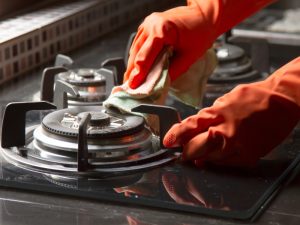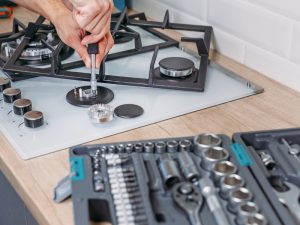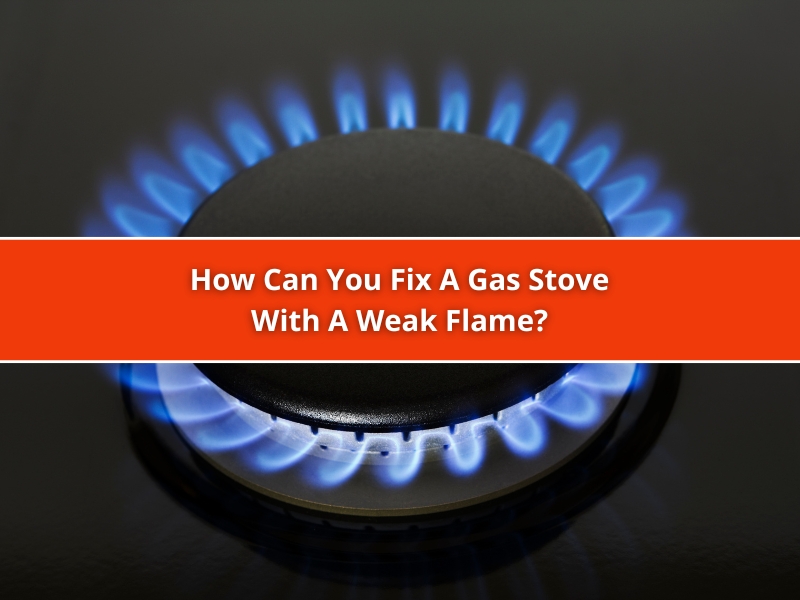A gas stove with a weak flame can be frustrating and inefficient. If it doesn’t produce enough heat, cooking becomes slow and uneven. Understanding the reasons behind a weak flame and knowing how to fix it can save you time and money. This guide covers the common causes, risks, and solutions to help restore your gas stove’s performance.
What causes a weak flame on a gas stove?
A weak flame on your gas stove can result from several factors.
Cause | Explanation |
Clogged burner ports | Food debris, grease, or dirt can block gas flow. |
Low gas pressure | Insufficient gas supply from the source reduces flame strength. |
Faulty gas regulator | A malfunctioning regulator affects gas flow. |
Airflow issues | Improper air-to-gas ratio leads to incomplete combustion. |
Damaged gas lines | Leaks or blockages in the gas line can restrict supply. |
What are the risks of using a gas stove with a weak flame?
A weak flame may seem like a minor issue, but it can lead to serious consequences. Here are the key risks to consider:
- Incomplete Combustion – A low flame may not burn gas efficiently, increasing the risk of carbon monoxide exposure.
- Gas Leaks – Weak flames may indicate blockages or leaks, which pose fire and explosion hazards.
- Food Safety Issues – Inconsistent heat can result in undercooked food, leading to potential health risks.
- Increased Gas Consumption – A struggling burner uses more gas to maintain temperature, increasing your gas bill.
If you notice a persistent weak flame, avoid using the stove until the issue is resolved. Additionally, if the gas stove burner fails to light properly, it can indicate an underlying issue, such as a clogged burner or faulty ignition system, which can affect both flame strength and safety.
How do you clean a gas stove burner for better performance?
Cleaning your gas stove burner regularly can restore proper flame strength. Here’s a simple step-by-step process:

- Turn Off the Gas Supply – Ensure safety by switching off the gas before cleaning.
- Remove Burner Grates and Caps – Take out all removable components for thorough cleaning.
- Soak Burner Parts in Warm, Soapy Water – Let them sit for 15–20 minutes to loosen the grease.
- Scrub with a Brush or Needle – Clear clogged burner ports with a toothbrush or needle.
- Rinse and Dry Completely – Moisture can interfere with ignition, so ensure all parts are fully dry.
- Reassemble and Test – Put everything back in place and turn on the stove to check for flame improvement.
Pro Tip: Clean your gas stove burners at least once a month to prevent weak flames and ensure smooth operation. Orange flames on a gas stove can indicate incomplete combustion, which leads to inefficient burning of gas and potentially dangerous situations.
How do you adjust the flame on a gas stove safely?
If your gas stove flame is too weak or uneven, you may need to adjust it manually.
- Check for Blockages First – Cleaning the burner should be the first step before adjusting the flame.
- Locate the Air Shutter or Gas Valve – Most stoves have an air shutter or adjustment screw under the burner.
- Adjust the Air Shutter – Turn it slightly to increase or decrease air intake for a balanced flame.
- Use the Control Knob – Adjust the flame using the control knob to ensure steady, blue flames.
- Test for Consistency – Light the stove and observe if the flame remains stable.
If adjustments don’t work, the problem may be related to gas pressure or faulty components, requiring professional intervention.
When should you call a professional for gas stove repair?
Some gas stove issues require expert attention. If you encounter any of the following, it’s important to address them promptly:

- Ensuring Proper Gas Line Installation – Adhering to gas line installation standards is essential to ensure safety, compliance with local regulations, and the efficient operation of your gas appliances.
- Persistent Weak Flame – If cleaning and adjustments don’t improve the flame.
- Hissing Sounds or Gas Smell – Possible gas leaks that need urgent inspection.
- Ignition Problems – If the stove takes too long to light or doesn’t ignite.
- Orange or Yellow Flames – Indicates incomplete combustion, which can produce carbon monoxide.
- Damaged Gas Lines – Visible cracks or wear on gas hoses or connectors.
- Gas Stove Malfunctioning – If your gas stove is not working properly, it could be due to issues like clogged burners, a faulty gas valve, or improper gas pressure, and it’s best to have it inspected by a professional.
Gas appliances should only be repaired by licensed professionals to ensure safety and compliance with Australian regulations.
What maintenance tips help prevent gas stove flame issues?
Regular maintenance can prevent weak flames.
Task | Frequency | Benefits |
Clean burners and ports | Monthly | Prevents blockages and maintains proper gas flow. |
Inspect gas lines | Every 6 months | Detects leaks early to prevent safety hazards. |
Check flame colour | Weekly | Ensures proper combustion and gas efficiency. |
Schedule professional servicing | Annually | Identifies hidden issues before they become major problems. |
Get Expert Gas Stove Repair Services in Sydney
A weak gas stove flame can be frustrating and dangerous if left unattended. While regular cleaning and minor adjustments can help, some issues require professional attention.
At Apex Gas Heater Service, we specialise in:
- Gas stove repair and installation
- Gas leak detection and safety inspections
- LPG and natural gas system servicing
- Gas line maintenance for residential and commercial properties
One of our customers mentioned being thoroughly satisfied with our service and highly recommending us for all gas-related needs. When it comes to gas appliances, safety and efficiency are key. If you’re experiencing issues with your gas stove, don’t wait for the problem to worsen. Reach out to Apex Gas Heater Service today for prompt and professional assistance, ensuring your gas stove performs at its best.

